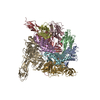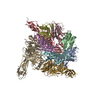+Search query
-Structure paper
| Title | About bacteriophage tail terminator and tail completion proteins: structure of the proximal extremity of siphophage T5 tail. |
|---|---|
| Journal, issue, pages | J Virol, Vol. 99, Issue 1, Page e0137624, Year 2025 |
| Publish date | Dec 23, 2024 |
 Authors Authors | Romain Linares / Cécile Breyton /  |
| PubMed Abstract | Bacteriophages are viruses infecting bacteria. The vast majority of them bear a tail, allowing host recognition, cell wall perforation, and DNA injection into the host cytoplasm. Using electron cryo- ...Bacteriophages are viruses infecting bacteria. The vast majority of them bear a tail, allowing host recognition, cell wall perforation, and DNA injection into the host cytoplasm. Using electron cryo-microscopy (cryo-EM) and single particle analysis, we determined the organization of the tail proximal extremity of siphophage T5 that possesses a long flexible tail and solved the structure of its tail terminator protein p142 (TrP). It allowed us to confirm the common evolutionary origin between T5 TrP and other known or putative TrPs from siphophages, myophages, and bacterial tail-like machines, despite very poor sequence conservation. By also determining the structure of the T5 tail proximal extremity after interaction with T5 bacterial receptor FhuA, we showed that no conformational changes occur in TrP and confirmed that the infection signal transduction is not carried by the tube itself. We also investigated the location of T5 Neck1 or tail completion protein p143 (TCP) and showed, thanks to a combination of cryo-EM and structure prediction using Alphafold2, that it is not located at the capsid-to-tail interface as suggested by its position in the genome, but instead, very unexpectedly, on the side of T5 tail tip, and that it appears to be monomeric. Based on structure comparison with other putative TCPs predicted structures, this feature could not be shared by other TCPs and questions the affiliation of p143 to this family of protein.IMPORTANCEBacteriophages, viruses infecting bacteria, are the most abundant living entities on Earth. They are present in all ecosystems where bacteria develop and are instrumental in the regulation, diversity, evolution, and pathogeny of microbial populations. Moreover, with the increasing number of pathogenic strains resistant to antibiotics, virulent phages are considered a serious alternative or complement to classical treatments. 96% of all phages present a tail that allows host recognition and safe channeling of the DNA to the host cytoplasm. We present the atomic model of the proximal extremity of the siphophage T5 tail, confirming structural similarities with other phages. This structure, combined with results previously published and further explored, also allowed a review and a discussion on the role and localization of a mysterious tail protein, the tail completion protein, which is known to be present in the phage tails, but that was never identified in a phage structure. |
 External links External links |  J Virol / J Virol /  PubMed:39714170 / PubMed:39714170 /  PubMed Central PubMed Central |
| Methods | EM (single particle) |
| Resolution | 3.88 - 4.05 Å |
| Structure data | EMDB-15967, PDB-8bcp: EMDB-15968, PDB-8bcu:  EMDB-51232: Unsymmetrized map of T5 phage tail tip complex, showing the monomeric Tail Completion Protein p143 |
| Source |
|
 Keywords Keywords | VIRAL PROTEIN / Bacteriophage / Siphophage / T5 / tail terminator / Trp |
 Movie
Movie Controller
Controller Structure viewers
Structure viewers About Yorodumi Papers
About Yorodumi Papers







 escherichia phage t5 (virus)
escherichia phage t5 (virus)